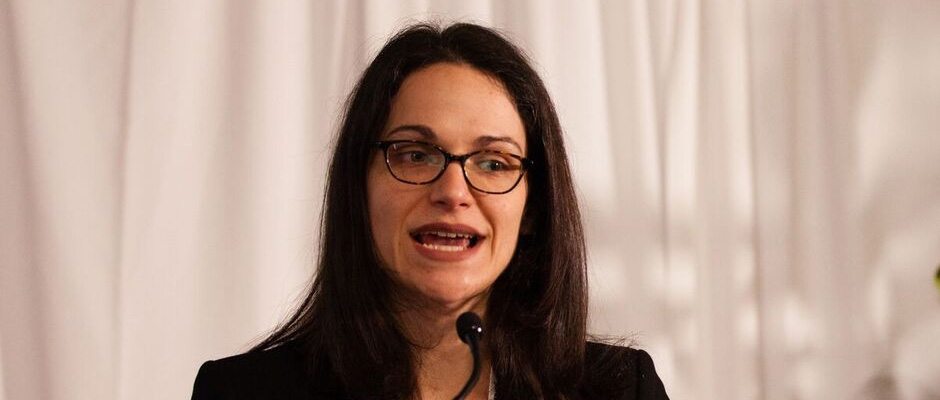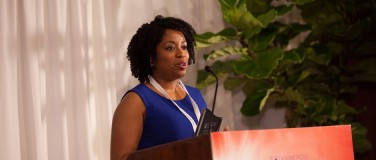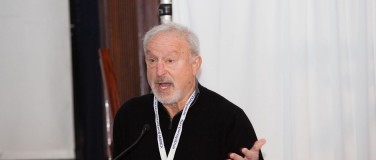PATIENT AWARENESS DAY 2018:
LIVING YOUR BEST LIFE WITH ENDO
Sunday, March 18, 2018, (8am-5pm) Einhorn Auditorium (131 E76th st) at Lenox Hill Hospital, NYC
How do adolescent girls and boys perceive symptoms suggestive of endometriosis among their peers? Findings from focus group discussions in New York City
- Thank you. There it is. Alright. Thank you. I'm so excited to be with you all today, to share our research. So thanks for giving me the time. I'll see if I can make up the overage, but no promises. So as we've shared, our research is really on how adolescent girls and boys perceive symptoms suggestive of endometriosis among their peers, and we did this through a focus group series right here in New York City. So I want to give a big shout out to our research team, our PI is from George Mason University, where I'm from. Sorry, I over-advanced, and I can't go back, but, there we go, from George Mason University, and that's Doctor Jhumka Gupta, and I've had the honor of working under her for a few years now, and then University of Pennsylvania as well, and then Arielle Dance, who is actually with us today. Hey Ariellefrom Saybrook University, and GetQualitative, as well as our funder, the Endometriosis Foundation of America, and then all the participating schools and organizations and then our amazing students who shared their perspectives.
So today I'm just gonna share background on the study, an overview of our themes, what the implications of those findings are, some of our next steps, and then hopefully we'll have time for discussion. Sorry, clicking is hard. So we're a team of public health researchers, and the way we define public health is what we, as a society, do collectively to assure the conditions in which people can be healthy. And one of the key ways to ensure we're doing our job well is to have accurate and reliable data because, if we don't have that, our programs won't be effective. So this wheel is just indicating that we begin with assessment and that's where we gather this reliable data to hopefully develop policies that are effective and then the assurance phase is really where we see if we've been effective or if we need to keep collecting more data. So when we think of conditions that influence health, I think a lot of us usually think of this, right? We've got the doctor's office, we've got our medications. Sorry guys, I'm clicker-dense. But this is what also influences health. We know that health happens where we live, work, learn and play. And so these are the conditions that really influence our health. So what's the public health response so far? We know that there's high prevalence of endo but there's been minimal public health response. As an example, for adolescent reproductive health issues, we've got curricula that focus on abstinence, safe sex and STI prevention while teen pregnancy impacts 2.4% of teens. And that's not to say that these aren't important issues that need to be addressed, but when you've got one in ten women experiencing endometriosis, and it's not being mentioned? That's a red flag. So this is the Socio-Ecological Model and it's something that we use in our field because we know that there's so many influencers of health, we use this to analyze what factors are important at these various levels, and that helps us inform our response. And similar to endometriosis, intimate partner violence is something that's difficult to talk about, and it's impacted by gender norms. And it's also something that we research on our team. And it was only after two decades of data collection that we were able to start putting programs into place. So data make the invisible visible, and that's what we're trying to do with endometriosis. Here's how we conducted our study. A focus group is a guided discussion that's used to understand norms around a public health issue and we used vignettes as a way to guide the focus groups, and I'll be explaining more on those in a minute. So this is where our focus groups occurred. As you can see, we were all over the city, and we were very fortunate to have a wide range of schools and organizations that were eager to participate in the research. So how are you going to ask people about a movie that they've never seen? Right? It would be difficult. And that was one of the biggest challenges we had in doing this research. If people don't even know what endometriosis means, how are we supposed to assess their perceptions? So we had this idea of using vignettes, and we used them to explore perceptions of help-seeking opportunities and factors that might shape girls' experiences of endometriosis-related symptoms, at that individual level, the family level, among their peers and school personnel, and then in community and society overall, as well. So the specific vignettes for our study, We had four vignettes, and excuse me, sorry. We started with Amanda and her sports team. She was the captain of her volleyball team, and she was missing games and practices because she was having heavy bleedings, stabbing pain, and was passing out, and she was being dismissed by her closed peers.
Our next vignette was Dominique and her good grades. Dominique was a straight-A student and then had to miss a lot of school due to her severe pain and heavy cramping and she was dismissed by the school nurse, and feared being dismissed by her parents and being disbelieved at home. And then Sam and her relationship. Sam was having painful sex and vomiting, and she wasn't sure how to discuss it with her boyfriend or her peers, and certainly not with her family. And then Bianca and her quinceanera. Bianca was having painful bowel movements, and she worried that they may prohibit her from being able to go to her big event. And she was too embarrassed to share this with her family. So, as you can see, we tried to capture a wide range of social scenarios and experiences. So all of these focus groups were recorded and we transcribed them verbatim and what that means is, I literally wrote every word including every like, um and giggle. And I'll show you an example in the next slide of what that looks like. So this is an example, there's a lot going on in this slide but I just wanted to show you what our codebook looked like. So we uploaded our transcriptions into software to analyze qualitative data. And down at the very bottom, you can see, we have help-seeking, sex, etc. That's our codebook and so that's where we would put our different data points and themes and we grouped those by vignette and then by code. And we had two coders going through the data individually, and they were each trained in the same fashion, so that they were coding in the same way, and then they'd get together to reconcile any discrepancies, and that's how you get to inter-rater reliability. And the standard target is 85% inter-rater reliability, and we hit 87.8%. So we had 54 participants, and they ranged in age from 14 to 18. Most were girls, and a large percent were Hispanic or Latino who were born in the US, with about half with parents born outside the US. So we really got a diverse sample. So now going back to the Socio-Ecological Model that I showed you earlier, we used that model to organize and analyze our themes. As you can see, there is a lot going on here. This is the diagram we're using in our manuscript and all the arrows can get a little wonky, but I just wanted to share this with you and then the next few slides, I'm going to break it down and share some examples. But this is how the different themes. We had 15 salient themes and this is how they interacted at each level of this model. So starting with Amanda and her volleyball team. Before I share some of the data, I just wanna acknowledge that for many of the patients in this room, many of these themes may be similar to what you have experienced, and from just what I've heard so far, I think that that's true. And this is what our teen boys and girls had to say if they were to encounter somebody like Amanda. And I just want, just remember these are data that show what an endometriosis patient's social circle might think of her experiences, and that's what we can use to create campaigns. So there were four themes that emerged from Amanda's story. The first being that menstrual stigma can prevent help-seeking. The second being compounded stigma faced by female athletes. Invisible symptoms influencing perceptions of suffering. And self-doubt and isolation. And now I'm gonna share a few quotes. One participant shared, I feel like if one time every single month she's more down and then everyone's like oh yeah it's her time again or there she goes again you know not pulling her weight as part of the team, it makes it harder for her. And so I guess maybe to protect her integrity as an athlete and to just not be a target she probably would be less willing to share when it's happening and what exactly she's going through. Another participant shared a girl facing repeated disbelief may start to feel like they're overreacting, even though everything they're saying is valid in terms of their body and what they are feeling. For Dominique and her good grades and all of her missing school; there were three themes that emerged, including lack of training among school personnel and that included the school nurses. Comparisons between endometriosis symptoms and mental health as well as educational costs of symptoms of endometriosis and subsequent psychological distress. One participant shared the school nurse feels like she understands Dominique's pain, so it's like, oh it's nothing. I've gone through the same thing. She's like oh I know this already. There's no way her pain is that bad. So, at some point the school nurse would feel like she can relate to Dominique and so it's just like, oh she'll get over it. It's nothing. Another participant shared yeah I'd be kind of like devastated. Honestly like if I worked that hard and then like something out of my control like you worked so hard to get those grades and once something out of your control kind of like gets in the picture it's like really frustrating. Every like and um. And then with Sam, we had four themes emerge, including painful sex and isolation gender norms inhibiting discussion of painful sex with male partners, painful sex and girls' fear of gossip, attitudes toward teen sex inhibiting discussion with adult caregivers about painful sex. And this was one of the harder vignettes to analyze because out of 54 participants, we literally only had one who shared that Sam should be able to talk to her boyfriend about it. And that'll come up in a quote. I just wanted to add that. Sam wants to please her boyfriend, but even though she knows that it's gonna hurt, she kina just wants to, like, sit there and take it, because she wants to please her boyfriend. Sam won't communicate with her boyfriend about experiencing painful sex because probably she feels like, he might think that she got an STI or something. Because sometimes, when you do have sex with somebody, and you have a sexually transmitted disease, it hurts so he might judge her. She's hesitant, or uncomfortable because she's probably afraid of the response or of how he would react. And then finally with Bianca and her quinceanera and her painful bowel movements. I will say this was the most difficult for participants to talk about which just gets at how stigmatized GI issues are in general. And then especially with endometriosis added in. So four themes emerged here, including gastrointestinal symptoms and ridicule from peers, peers unable to relate to debilitating GI symptoms, girls distrust healthcare providers to respect them and to take their health issues seriously, and then gastrointestinal symptoms impacting girls' social functioning. One participant shared, I feel like doctors, because like, there are so many patients outside, or things get like overcrowded or whatever, so they have to make things fast and you tell them a problem, they find a fast fix, instead of going really deep into the issue. One participant shared that Bianca would feel embarrassed because she would have to go to the bathroom every two seconds. I would be embarrassed cause like what if I worked so hard to have a party and then can't go to it anymore? So, as with all research, our study did have some limitations. And the biggest that I wanted to share is just that our vignettes were developed with reflection from adults experiencing endometriosis and what that was like for them in adolescence. And so they lack that social media context that really is impacting today's adolescents. Some of the strengths of our study is that it's one of the first to really target and added recruitment of adolescents of color and so this extends the inclusiveness of existing research. Additionally, the vignettes facilitated conversation of a stigmatized issue, and then, it was one of the first studies to look at the social context interaction for teens with symptoms suggestive of endometriosis, which allows us to really explore social, educational, and medical perceptions. We do have several implications and we need good data to inform our programs and it's never a good idea to implement a program without collecting data to understand what's going on.
So with that in mind, our data can inform public health campaigns in the following ways: we need to inform adolescents, their peers, networks, families, schools, and the health sector about endometriosis and its symptoms. This has to include stigma reduction efforts and, as information alone is not sufficient, we need to engage male and female peers to foster supportive social climates. We also need to develop validated measures to assess the population-wide burden of symptoms suggestive of endometriosis in adolescent populations. This should include measures to assess societal attitudes toward endometriosis and its symptoms, and these measures will help monitor and evaluate efforts to determine potential attitudinal shifts. For next steps, we're working an an app to improve social support for adolescent endometriosis patients. It's a phone-based game that we're hoping will help adolescents with endometriosis get better social support and so that's underway now, with the help of the themes we found in our study. So I'm here to follow up with any questions you might have and if we aren't able to get to your question today, you can follow up with Doctor Gupta, who apologizes for not being here today. And then this her contact info including Twitter.
- Great. Thank you so much.










